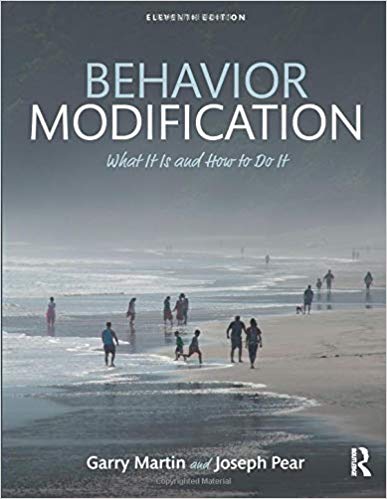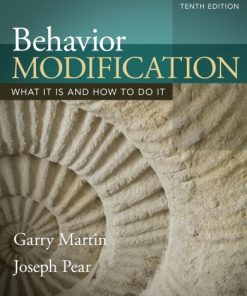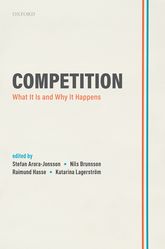(eBook PDF) Behavior Modification: What It Is and How To Do It 11th Edition
$50.00 Original price was: $50.00.$25.00Current price is: $25.00.
(eBook PDF) Behavior Modification: What It Is and How To Do It 11th Edition – Digital Instant Dowload.
(eBook PDF) Behavior Modification: What It Is and How To Do It 11th Edition – Digital Instant Dowload.

Product details:
Author: Garry Martin; Joseph J. Pear
Behavior Modification: What It Is and How to Do It is a comprehensive, practical presentation of the principles of behavior modification and guidelines for their application. Appropriate for university students and for the general reader, it teaches forms of behavior modification ranging from helping children learn necessary life skills to training pets, to solving personal behavior problems. It teaches practical “how-to” skills, including: discerning long-term effects; designing, implementing, and evaluating behavioral programs; interpreting behavioral episodes; observing and recording behaviors; and recognizing instances of reinforcement, extinction, and punishment.
Behavior Modification is ideal for courses in Behavior Modification, Applied Behavior Analysis, Behavior Therapy, the Psychology of Learning, and related areas; and for students and practitioners of various helping professions (such as clinical psychology, counselling, education, medicine, nursing, occupational therapy, physiotherapy, psychiatric nursing, psychiatry, social work, speech therapy, and sport psychology) who are concerned directly with enhancing various forms of behavior development. The material is presented in an interesting, readable format that assumes no prior knowledge of behavior modification or psychology.
Table contents:
Part I: The Behavior Modification Approach
1. Introduction
2. Areas of Application: An Overview
3. Defining, Measuring, and Recording Target Behavior
4. Doing Behavior Modification Research
Part II: Basic Behavioral Principles and Procedures
5. Respondent (Classical, Pavlovian) Conditioning of Reflexive Behavior
6. Increasing a Behavior with Positive Reinforcement
7. Increasing Behavior with Conditioned Reinforcement
8. Decreasing a Behavior with Operant Extinction
9. Getting a New Behavior to Occur with Shaping
10. Developing Behavioral Persistence with Schedules of Reinforcement
11. Responding at the Right Time and Place: Operant Stimulus Discrimination and Stimulus Generalization
12. Changing the Control of a Behavior with Fading
13. Getting a New Sequence of Behaviors to Occur with Behavior Chaining
14. Differential Reinforcement Procedures to Decrease Behavior
15. Decreasing Behavior with Punishment
16. Establishing Behavior by Escape and Avoidance Conditioning
17. Respondent and Operant Conditioning Together
18. Transferring Behavior to New Settings and Making It Last: Programming of Generality of Behavior Change
Part III: Capitalizing on Operant Antecedent Control Procedures
19. Antecedent Control: Rules and Goals
20. Antecedent Control: Modeling, Physical Guidance, and Situational Inducement
21. Antecedent Control: Motivation
Part IV: Putting It All Together to Develop Effective Behavioral Programs
22. Functional Assessment of Causes of Problem Behavior
23. Planning, Applying, and Evaluating a Behavioral Program
24. Token Economies
25. Helping an Individual to Develop Self-Control
Part V: Behavior Therapy for Psychological Disorders
26. Behavioral Approaches to Psychotherapy: Cognitive Restructuring, Self-Directed Coping Methods, and Mindfulness and Acceptance Procedures
27. Psychological Disorders Treated by Behavioral and Cognitive-Behavioral Therapies
Part VI: A Historical Perspective and Ethical Issues
28. Giving it All Some Perspective: A Brief History
29. Ethical Issues
Glossary
References
Author Index
Subject Index
You may also like…
Uncategorized
Book Review: Cogs and Monsters: What Economics Is and What It Should Be Jamin Andreas Hübner
Business & Economics
Relationships & Lifestyle - Psychological Self-Help
Politics & Philosophy - Social Sciences
Uncategorized












